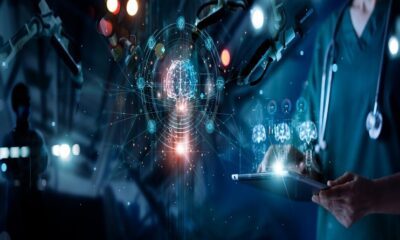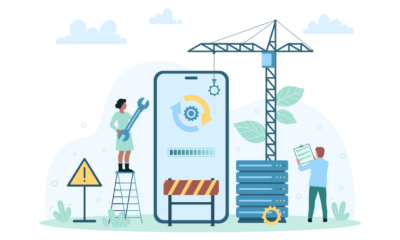
The recent rise of gen AI has firmly established this decade as the AI era. The AI evolution timeline has been long and exciting, from the Turing test in 1950 to the public launch of GPT in 2018. Read on to learn how we are gradually moving from AI-enabled automation toward the age of augmentation.
What Are the Key Areas of AI Evolution?
As we move from the era of automation to augmentation, the most notable areas of AI evolution include:
1. Advancements in machine learning and deep learning
Machine learning (ML) has evolved significantly in the last few years – particularly with the emergence of deep learning techniques.
Initially, ML algorithms were primarily based on statistical methods, such as linear regression and decision trees. However, with the advent of deep learning, AI systems can now autonomously learn hierarchical representations of data. This is possible thanks to neural networks with multiple layers, which allow AI to extract intricate patterns and features from complex datasets.
Deep learning architectures, such as convolutional neural networks (CNNs) for image recognition and recurrent neural networks (RNNs) for sequential data processing, have revolutionized more domains than we can count. These architectures can automatically learn hierarchical representations of data, a foundational ability for image classification, speech recognition, and natural language understanding with unprecedented accuracy.
These advancements haven’t happened in isolation. Instead, they have been propelled by improvements in computational power, data availability, and algorithmic innovations. Techniques like batch normalization, dropout regularization, and advanced optimization algorithms (e.g., Adam, RMSprop) have enhanced training stability and convergence speed, a testament to today’s developer skills.
2. Natural language processing and conversational AI
NLP has evolved from rule-based systems to data-driven approaches on a parallel track, taking off from ML and deep learning techniques.
Early NLP systems relied on handcrafted rules and linguistic resources, often needing more clarity and context dependency. However, with the growing use of statistical methods and later deep learning, NLP systems can accurately process and understand natural language.
Consider, for instance, word embeddings like Word2Vec and GloVe. These represent words as dense vectors in a continuous semantic space. Embeddings capture semantic similarities and relationships between words, enabling NLP models to understand context and meaning better.
Similarly, conversational AI has witnessed significant progress, driven by advancements in natural language understanding (NLU) and natural language generation (NLG).
Today, state-of-the-art chatbots and virtual assistants employ sophisticated deep learning architectures, such as transformer models (e.g., BERT, GPT), which excel at capturing long-range dependencies and context in natural language.
Furthermore, techniques like reinforcement learning allow conversational agents to figure out the best way to engage in dialogues and fulfill user requests over extended interactions, just like human beings. These agents can adapt their responses based on user feedback, leading to more personalized and effective conversational experiences.
3. AI in cyber-physical robotics and autonomous systems
Thanks to artificial intelligence, robotics, and machine automation have evolved in leaps and bounds –from traditional industrial robots programmed for repetitive tasks to intelligent systems capable of perception, decision-making, and interaction with their environment.
IoT advancements have also helped. Sensor technology, particularly in the fields of computer vision and LiDAR (Light Detection and Ranging), has empowered robots to perceive and interpret their surroundings in real-time. This, combined with object detection and semantic segmentation, enables robots to recognize and localize objects with high precision.
Today, it is commonplace to have robots perform complex mechanical tasks like pick-and-place operations and navigation in dynamic environments.
Reinforcement learning algorithms have also been instrumental in training autonomous systems. They help learn complex behaviors and action policies through trial and error. This approach has led to the development of autonomous vehicles and drones capable of performing tasks with minimal human intervention.
Recently, we have seen the rise of collaborative robotics (cobots), which focus on human-robot interaction and cooperation in shared workspaces. These systems leverage AI to ensure safety, adaptability, and intuitive collaboration between humans and robots – opening up new possibilities for flexible and efficient manufacturing processes.
What Does AI Evolution Mean for You? Implications for Various Industries
The evolution of artificial intelligence has touched nearly every industry, from manufacturing to healthcare. Overall, it enables efficiency and lowers risk, freeing up human workers for more strategic tasks—but it also displaces some of the workforce, as we will discuss later.
In healthcare, AI’s evolution is like having a super-smart assistant for doctors. Imagine a virtual brain that sifts through mountains of patient data in seconds, helping doctors make better decisions. From analyzing medical images to scanning patient records, AI algorithms are razor-sharp, spotting patterns and clues that might go unnoticed.
This means faster diagnoses, personalized treatment plans, and better patient outcomes.
In manufacturing, AI is the ultimate factory worker. Think of it as having a team of robotic colleagues who handle the heavy lifting and predict when machines might malfunction. Armed with AI brains, these smart machines work hand-in-hand with human employees, taking care of repetitive tasks and ensuring everything runs like a well-oiled machine.
With predictive maintenance and seamless automation, factories become more efficient, products are made faster, and quality increases – eventually leading to lights-out manufacturing.
In finance, AI places a financial wizard in every user’s pocket. It’s almost like a personalized friend who monitors the stock market, analyzes trends, and gathers investment tips. From trading algorithms that execute lightning-fast transactions to chatbots that offer personalized financial advice, AI is changing the game.
It’s not just about making money; it’s about managing risks smarter and helping investors make confident decisions. With AI, finance becomes more accessible, secure, and tailored to individual needs.
AI Evolution Leads to New Ethical and Societal Considerations
As artificial intelligence evolves, we need to tackle several ethical questions about its present and future impacts:
1. How do you address bias and fairness in AI systems?
Ensuring fairness and mitigating bias is paramount to fostering trust among users. However, achieving fairness in AI systems is complex due to various factors such as data, algorithmic, and societal biases.
Techniques like data auditing, bias detection algorithms, and diverse dataset collection can help identify and mitigate biases. You may also consider implementing fairness-aware algorithms that account for protected attributes (e.g., race, gender) to ensure equitable outcomes.
2. What is the impact of AI on employment and society?
Integrating AI technologies into various industries has profound implications for employment dynamics and societal structures. While AI can enhance productivity and efficiency, it also poses challenges related to job displacement, skill mismatches, and socioeconomic inequality – for instance, between mature economies with wider AI access and developing economies.
Addressing digital divide issues through inclusive AI education initiatives and equitable access to AI resources can help mitigate some of these disparities. Workforce adaptation methods — through lifelong learning programs, career counseling, and flexible labor policies — can facilitate smoother transitions in the AI-driven economy.
3. How do you maintain quality and the human touch amid AI proliferation?
As AI technologies proliferate, preserving quality and human-centric values becomes increasingly crucial. Organizations must proactively aim to avoid dehumanization in creative fields like content creation and marketing.
Implement monitoring guardrails to assess AI performance and user satisfaction, allowing for timely adjustments and improvements based on feedback. You could also integrate AI technologies with human expertise to create hybrid operational models, which combine the efficiency of automation with the empathy and nuanced understanding of human workers – resulting in true augmentation.
What Are the Future Directions of AI Evolution?
As artificial intelligence evolves, it will increasingly converge with other powerful technologies, such as the Internet of Things (IoT) and quantum computing, to create more seamless digital landscapes for future generations.
The artificial intelligence of things (IoT) is a budding field of research and investment, exploring combined use cases of these two technologies in healthcare, manufacturing, supply chains, smart cities, and more. Similarly, quantum computing enables AI systems to learn faster and generate more accurate inferences. Google has an ongoing Quantum AI competition with a $5 million reward for developments in quantum algorithms.
The evolution of AI is far from over, and as computing resources become more widely accessible, we can look forward to several remarkable milestones in the years ahead.
Download the whitepaper on the Key Trends in Machine Learning, AI, and Cloud. Follow us on LinkedIn for more insights.








